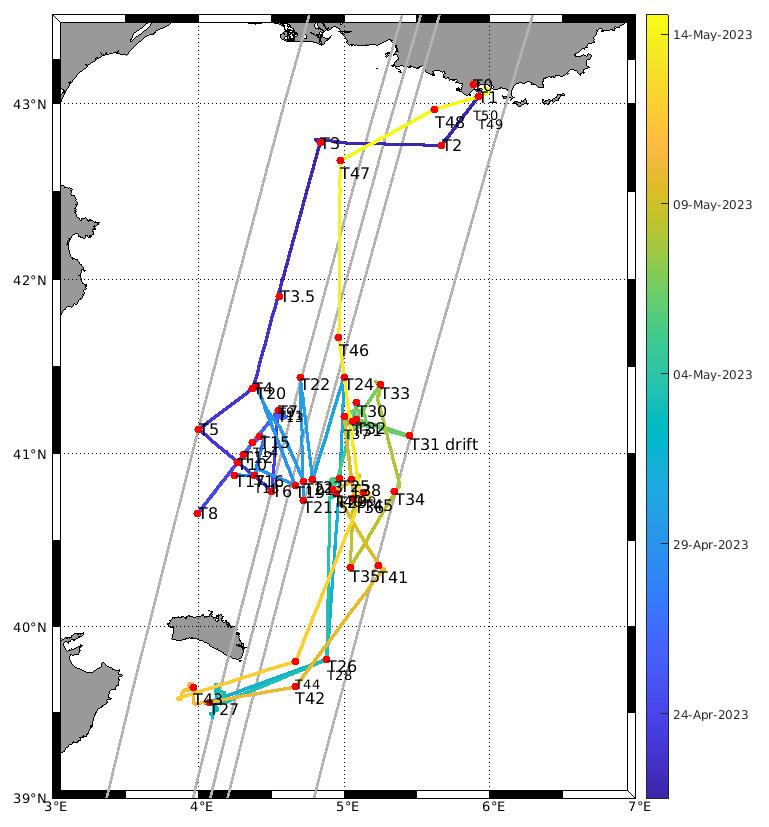BioSWOT-Med
| Type | Oceanographic cruise |
|---|---|
| Ship | L'Atalante |
| Ship owner | Ifremer |
| Dates | 21/04/2023 - 15/05/2023 |
| Chief scientist(s) | DOGLIOLI Andrea , GREGORI Gérald |
INSTITUT MÉDITERRANÉEN D'OCÉANOLOGIE - UMR 7294 UMR IRD 235 - MARSEILLE 163 avenue de Luminy Bâtiment Méditerranée 13288 Marseille Cedex 9 +33(0)4 86 09 05 00 |
|
| DOI | 10.17600/18002392 |
| Objective | The oceanic fine scales (1-100 km) have relatively short lifetimes (days to weeks) but crucially affect ocean physics and ecology up to the climate scale, due to the strong gradients created by their energetic dynamics. These gradients are associated with strong vertical transport connecting the ocean's upper layer to its interior. Moreover, the temporal scale associated with this horizontal and vertical dynamics is the same as that of many important oceanic processes including biogeochemical cycles, biodiversity, fish distribution, and even foraging strategies of the mega-fauna. Over the past few decades numerous numerical studies with physical and biophysical configurations for km-scale processes allowed significant progress in characterizing this regime. Field campaigns have also shown that individual fine-scale features may be experimentally targeted, but these in situ studies are usually biased by the choice of targeting the stronger and longer-lived features. Then, an important lack of empirical evidence for fine-scale processes remains. The scientific community has been focusing large efforts on novel platforms. Among these are satellite missions that provide extended coverage and high spatio-temporal resolution of the ocean surface. Obviously, remote sensing does not provide ground truth of all fine-scale physical and biophysical processes, but can provide a critical resource that helps to define the synoptic context of fine-scale features, helping to disentangle spatial from temporal variability, supporting adaptive in-situ sampling strategies, and assessing the representativeness of field data. In this context, the NASA-CNES satellite SWOT (Surface Water and Ocean Topography), launched on 16 December 2022, is the most ground-breaking mission for ocean science in the near future. Indeed, with respect to current nadir measurements the new SWOT altimeter sees two-dimensional scenes, like sea surface temperature and ocean color, but without being affected by clouds. Moreover, during its initial so-called « fast sampling phase », it associates to high spatial resolution a 1-day revisit period over ~150 km wide oceanic regions, a feat never achieved in the past, and not expected from other planned missions in the future. The BIOSWOT-AdAC project (PI F.d'Ovidio, A.Doglioli, G.Grégori, S.Speich and P.Garreau), funded by the NASA-CNES joint call for the SWOT Science Team, focuses on the specific opportunities of the SWOT fast sampling phase, promoting the international consortium SWOT-AdAC endorsed by CLIVAR, coordinating several field campaigns during this specific period of the satellite mission. The BIOSWOT-Med campaign contributes to this international effort, focusing on the Western Mediterranean Sea. The latter is the ideal area to verify the hypothesis considering the fine scale circulation as the driver of the plankton biodiversity. Indeed, here a high biodiversity is associated to conditions of oligotrophy and moderate energy, unlike oceanic areas as western boundary currents or eastern boundary upwellings that are largely explored and where the intense dynamics or the large nutrient input can mask the fine-scale coupled dynamics. An adaptive and Lagrangian sampling strategy was applied combined with innovative methodologies allowing to obtain high spatio-temporal resolution multidisciplinary measurements in the SWOT swaths (see figure below, with the SWOT ground tracks in gray and the ship's route colored by date).
The BIOSWOT-Med cruise aims to improve our understanding of the coupling of physical processes to biological ones from viruses to zooplankton. As the Mediterranean conditions are representative of a large majority of the world Ocean, our research has a global significance. Moreover, our highly interdisciplinary research it aims to highlight the importance of the SWOT mission data for biogeochemical and ecological studies. Finally, our in-situ experiment will also bridge a long-standing gap between modelling and global observations for assessing the role of the ocean fine scale on the Earth system. |

